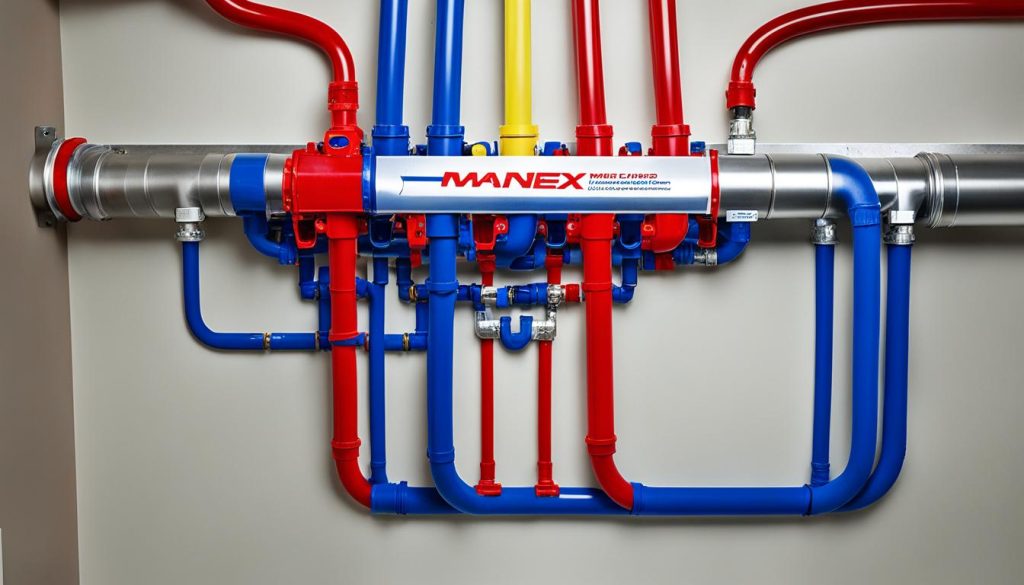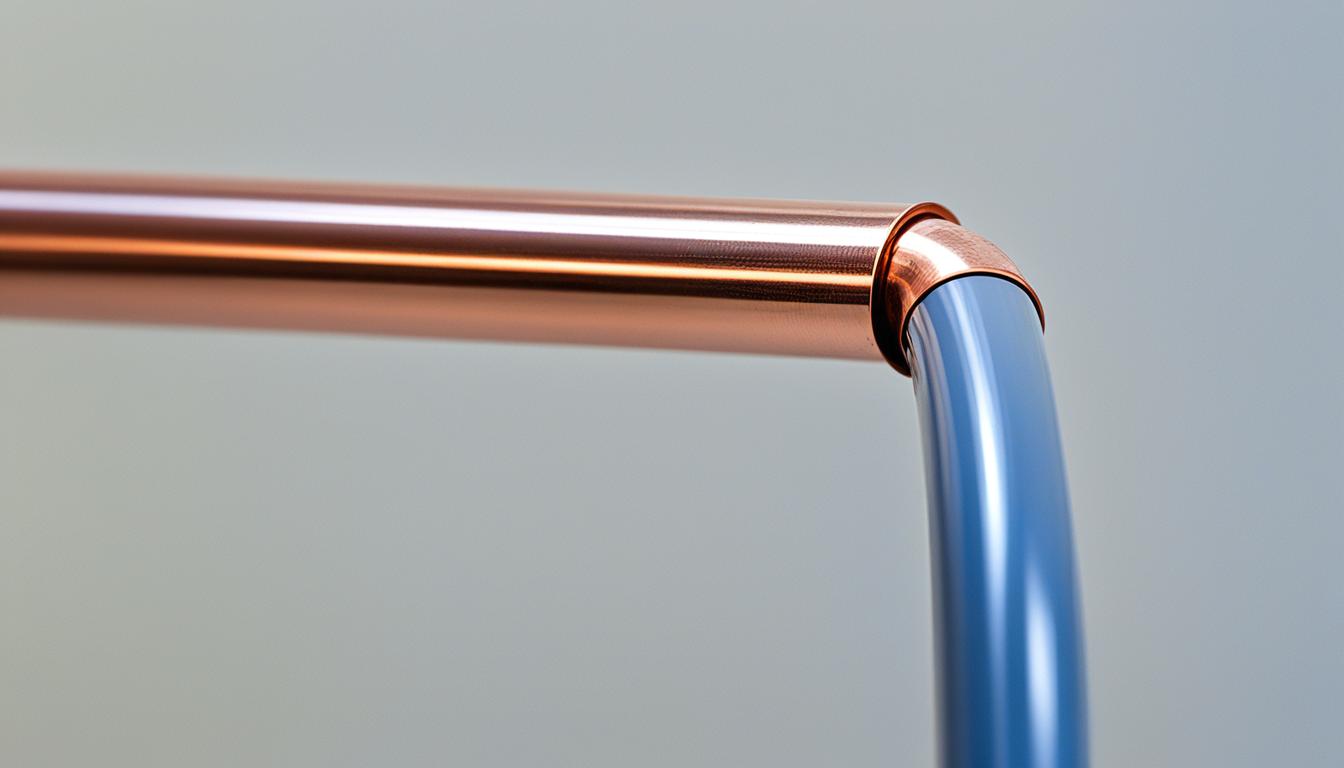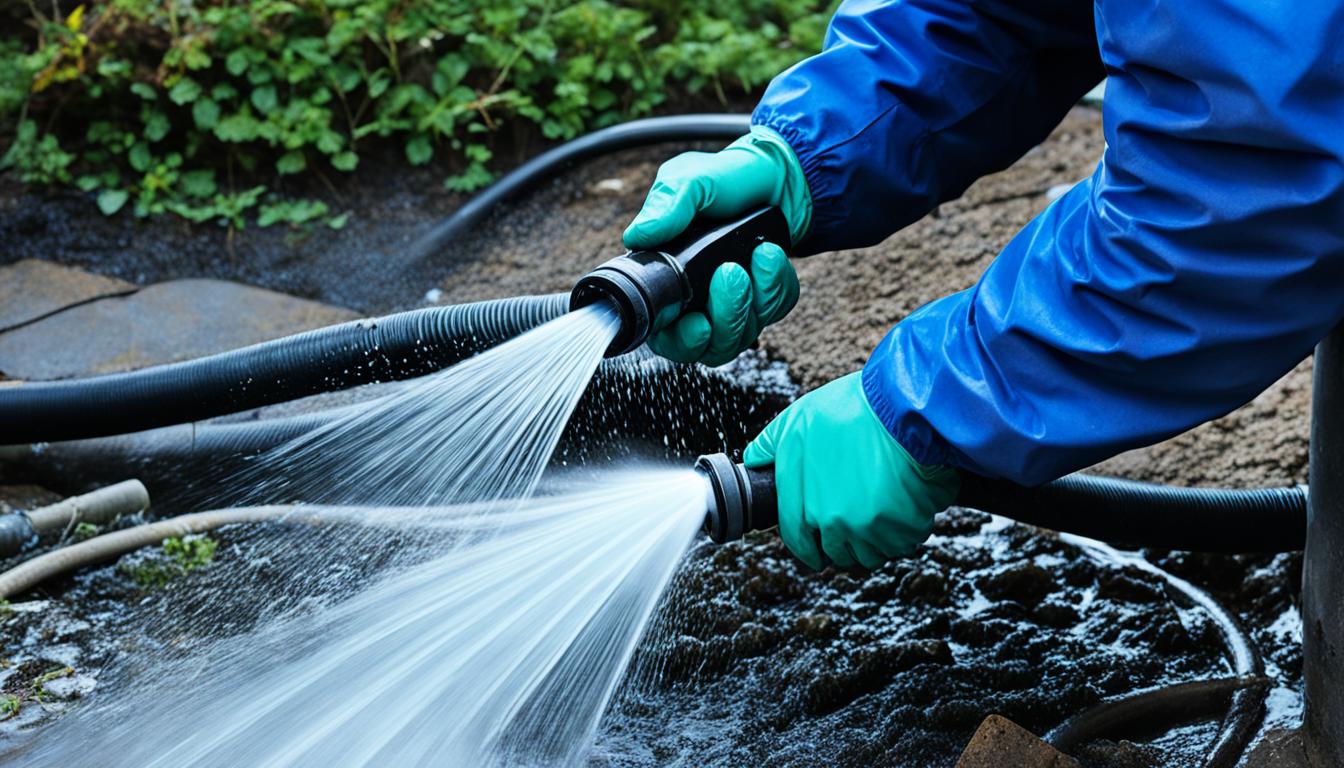PEX Pipe Guide: Benefits & Installation Tips
Did you know that PEX piping, also known as cross-linked polyethylene, is rapidly replacing traditional copper pipes in residential plumbing systems? This versatile and durable material offers a range of benefits that make it a popular choice for homeowners and plumbers alike.
PEX pipes are not only cost-effective but also offer faster installation and greater flexibility compared to copper pipes. They are highly durable, resistant to corrosion, and unaffected by acidic water. Whether you need to splice PEX fittings into your existing pipes or utilize a manifold system for better water distribution, PEX pipes provide a reliable and cost-effective solution.
It’s important to note that PEX pipes come in different grades, such as PEX-A, PEX-B, and PEX-C, each with its own unique characteristics. Proper installation and adherence to local plumbing codes are crucial to ensure the reliability and longevity of PEX plumbing systems.
Key Takeaways:
- PEX piping offers several advantages over copper pipes, including lower cost and faster installation.
- PEX pipes are highly durable, resistant to corrosion, and unaffected by acidic water.
- Proper installation and adherence to plumbing codes are essential for a reliable PEX plumbing system.
- PEX pipes come in different grades, such as PEX-A, PEX-B, and PEX-C, each with its own unique characteristics.
- Using manifolds can simplify plumbing runs and improve water distribution in a PEX system.
What is PEX Piping?
PEX piping, also known as cross-linked polyethylene, is a versatile and cost-effective plumbing pipe material that is widely used in residential plumbing systems. Its popularity stems from its lower cost compared to copper pipes and its ease of installation.
PEX piping is available in two forms: coils and sticks. While coils are convenient for longer runs and reducing the number of fittings, sticks are generally preferred for most jobs to avoid kinks and frustration. The flexibility of PEX piping allows for easier remodeling projects and faster installation.
One of the key benefits of PEX piping is its “memory” feature, meaning it retains its original shape even after being bent or coiled. This characteristic makes PEX piping suitable for various plumbing applications and ensures a reliable and durable plumbing system.
To give you a better understanding, here is a comparison table outlining the main features of PEX piping:
| Feature | PEX Piping | Copper Pipes |
|---|---|---|
| Cost | Lower | Higher |
| Installation Ease | Easy | Requires soldering |
| Flexibility | Highly flexible | Less flexible |
| Corrosion Resistance | Corrosion-resistant | Potential for corrosion |
As you can see, PEX piping offers several advantages, including cost-effectiveness, ease of installation, flexibility, and corrosion resistance. These factors make it an excellent choice for residential plumbing systems.
Now that you understand what PEX piping is, let’s dive deeper into the debate between PEX and copper pipes in the next section.
Which is Better – PEX or Copper?
When it comes to choosing the right plumbing material for your home, PEX and copper are two popular options. Let’s explore the advantages of PEX pipes over copper pipes to help you make an informed decision.
Cost
One of the significant advantages of PEX pipes is their cost-effectiveness. PEX pipes cost only about one-third of the price of copper pipes, offering substantial savings, especially for medium-to-large plumbing jobs. With PEX pipes, you can achieve the same level of quality and functionality at a fraction of the cost.
Installation
When it comes to installation, PEX pipes have a clear advantage over copper pipes. Installing PEX pipes is faster and easier compared to the traditional soldering method required for copper pipes. PEX pipes use fittings that can be easily connected using crimp rings or cinch clamps, eliminating the need for complex soldering techniques.
Corrosion Resistance
PEX pipes are not susceptible to corrosion, making them an excellent choice for areas with acidic water. Unlike copper pipes that can erode over time due to chemical reactions with water, PEX pipes remain unaffected and maintain their integrity, ensuring long-term durability and reliability.
Overall, PEX pipes offer several advantages over copper pipes, including cost-effectiveness, easier installation, and resistance to corrosion. They provide a reliable and efficient solution for your plumbing needs, ensuring both convenience and savings in the long run.
Stay tuned for the next section, where I’ll discuss the special tools required for working with PEX pipes.
Do I Need Special Tools?
When it comes to plumbing with PEX, having the right tools is essential for a successful installation. While there are various connection methods available, each requiring specific tools, there are a few practical options that DIYers can consider.
Crimp Rings: Crimp rings are metal bands that can securely connect PEX tubing to fittings. They are compressed using a crimp ring tool, creating a tight and reliable seal. This method is cost-effective and widely used for PEX installations.
Cinch Clamps: Cinch clamps, also known as pinch clamps or ring clamps, are another popular choice for connecting PEX fittings. These clamps work similarly to traditional band clamps, easily securing the tubing in place. They are a user-friendly option and do not require any specialized tools.
Scissors-Like Cutter: To achieve precise lengths of PEX tubing, a scissors-like cutter is necessary. This tool ensures clean and straight cuts, providing a professional finish to your installation.
While stab-in or compression fittings can also be used, they tend to be more expensive and may not be suitable for large projects. Crimp rings and cinch clamps offer practical and budget-friendly solutions for DIYers.
By using the right tools for your PEX plumbing project, you can ensure secure and reliable connections, promoting the longevity of your plumbing system.
How Do I Splice PEX Fittings Into My Existing Pipe?
If you need to splice PEX fittings into your existing pipe, there are several methods you can use. One common approach is to utilize a stab-in tee, which eliminates the need for soldering. Another option is to solder in a tee and a PEX supply adapter, and then connect the PEX supply tubing over the adapter using your preferred connection method. However, it’s crucial to check your local plumbing codes to ensure compliance with regulations. Stab-in tees can also be used to connect PEX fittings to CPVC pipes, but it’s important to read the label to determine the compatibility of the fittings.
When splicing PEX fittings into your existing pipe, consider the following steps:
- Select the appropriate method: Determine whether you will use a stab-in tee or solder in a tee and PEX supply adapter.
- Prepare the existing pipe: Cut the existing pipe at the desired location and make sure it is clean and free from debris.
- Follow the manufacturer’s instructions: Carefully follow the manufacturer’s guidelines for installing the stab-in tee or soldering the tee and PEX supply adapter.
- Connect the PEX supply tubing: Once the tee or PEX supply adapter is securely in place, connect the PEX supply tubing using your preferred connection method, such as crimp rings or cinch clamps.
- Pressure test the connection: Conduct a pressure test to ensure there are no leaks in the newly spliced PEX fittings.
It’s always recommended to consult a professional plumber if you’re unsure about the splicing process or if you encounter any difficulties. Proper installation is key to ensuring the reliability and longevity of your PEX plumbing system.
Pros and Cons of Splicing Methods
| Splicing Method | Pros | Cons |
|---|---|---|
| Stab-in Tee |
|
|
| Soldered Tee and PEX Supply Adapter |
|
|
Do I Have to Use Manifolds with PEX?
While PEX piping can be installed without using manifolds, utilizing them provides several advantages. Manifolds are a beneficial addition to your PEX plumbing system as they streamline the distribution of water and enhance overall performance.
The Home-Run System
The home-run system, a popular choice for PEX installations, involves installing a manifold near the main water line. This configuration allows for dedicated PEX tubes to each fixture, resulting in faster hot water delivery and better water pressure throughout your home. By eliminating the need for long, branch lines, the home-run system ensures that every faucet and shower receives an optimal supply of hot water without any lag time or fluctuations.
The Hybrid System
Another option is the hybrid system, which combines the advantages of the home-run system with a more compact design. In this system, three-quarter inch hot and cold lines are connected to a smaller manifold located behind an access panel. The hybrid system is ideal for areas with multiple fixtures in close proximity to each other, such as a bathroom. This configuration allows for efficient water distribution and minimizes the risk of pressure drops.
By using manifolds in your PEX plumbing system, you can simplify the layout of your water lines, reduce the number of fittings needed, and minimize the potential for leaks. Manifolds provide a centralized control point for your water supply, making maintenance and troubleshooting easier in the long run.
| Advantages of Using Manifolds with PEX |
|---|
| Improved water pressure and flow |
| Efficient hot water delivery |
| Minimized risk of leaks |
| Reduced fittings and connections |
Does it Meet Code?
It is essential to ensure that your PEX plumbing system complies with local plumbing codes and regulations. These codes can vary from one jurisdiction to another, so it’s crucial to consult with your local plumbing inspector or authorities before starting any PEX plumbing project. The inspection process will help ensure that your installation meets all the necessary safety standards and requirements outlined in the plumbing code.
By adhering to the local plumbing codes, you can avoid potential issues down the line and ensure the longevity and reliability of your PEX plumbing system. Failure to comply with the plumbing code may result in costly repairs, safety hazards, or even legal consequences.
Local plumbing codes typically cover various aspects of PEX plumbing installations, such as pipe sizing, fitting types, proper supports, insulation requirements, and more. The specific requirements will depend on factors such as the type of building, water supply, and intended use of the PEX system.
Experienced plumbing inspectors can provide valuable guidance and recommendations tailored to your specific project. They will help you understand the local requirements, assist in the design and planning phase, and conduct inspections throughout the installation process to ensure compliance every step of the way.
Remember, the plumbing code exists to protect you and your property, as well as to maintain the integrity and safety of the entire plumbing system. Investing the time and effort to meet code requirements will give you peace of mind and a reliable PEX plumbing system for years to come.
Is PEX Reliable?
When it comes to residential plumbing systems, reliability is paramount. And when properly installed and maintained, PEX (cross-linked polyethylene) delivers the reliability homeowners need. In fact, PEX has been used in countless homes around the world for decades, with thousands of leak-free systems to show for it.
It’s important to note that most issues encountered with PEX systems are usually not due to problems with the tubing itself, but rather the result of improper installation or faulty fittings. To ensure the reliability of your PEX system, it’s crucial to use high-quality PEX fittings and tubing and follow the recommended installation methods.
By adhering to plumbing guidelines and using the right materials, you can have confidence in the durability and longevity of your PEX plumbing system. Whether you’re replacing old pipes or installing a new system, PEX offers a reliable solution that can withstand the demands of everyday use.
Source Links
- https://www.familyhandyman.com/list/pex-piping-everything-you-need-to-know/
- https://www.tubomart.com/pex-pipes-a-complete-guide/
- https://www.plasticpipe.org/BuildingConstruction/BuildingConstruction/Publications/PEX-Design-Guide.aspx
- Investing Wisely: How Windows & Doors in Boost Property Value and Financial Health - April 24, 2025
- The Financial Impact of Personal Injuries: Why Legal Help Matters for Business Owners - April 16, 2025
- The Hidden Financial Costs of Domestic Assault: What Business Owners Need to Know - April 16, 2025














